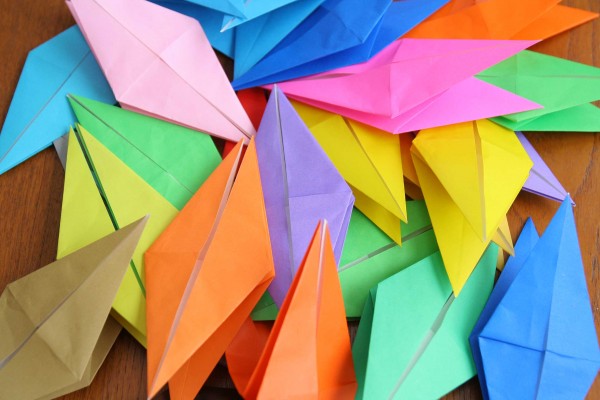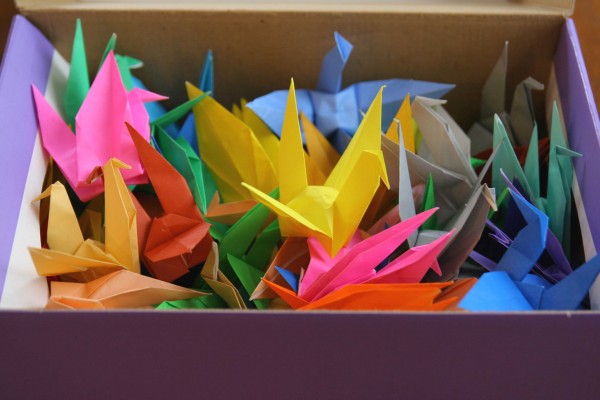In Japanese culture, origami paper cranes symbolize hope and wishes granted. Legend has it that if a person folds one thousand cranes, their wishes would be fulfilled. It only seems fitting, in the wake of the devastating Sendai earthquake, to share this tradition with our children.
Each month, I volunteer as an art docent in my kids’ elementary school. That means that I lead each of their classes in an lesson about a famous artist or style and then show the students how they can create a work using similar techniques. There just happens to be another mom, Emiko, in my Kindergartener’s class who is from Japan, and she offered to help me teach the traditional method of folding origami cranes.
“It might be too difficult for them,” another Japanese American parent warned me.
Always the hopeless idealist, I was undaunted. We’ll do it slowly, step by step, and walk them through it. They’ll be so proud when they see the finished string of birds hanging from the ceiling!
In preparation for the lesson, Emiko showed me how to fold the cranes. “This is the really traditional way I learned as a girl,” she explained, as her fingers deftly bent, creased, and flipped the sheets. While mine weren’t terrible, they weren’t perfect. When folding a complicated piece of origami, it is essential that the corners are exactly aligned and the creases razor-sharp. A little imperfection in the early stages of folding stays is not hidden by the many subsequent layers of. Instead, an imperceptible misalignment is magnified as the project progresses, finally revealing itself in lopsided wings or awkward corners in the final product. How many symbolic lessons are there in one little paper crane?
Zen and the Art of Origami
We decided to partially fold the papers for the Kindergarteners, getting the project past the point where corners need to meet in complicated angles. After the kids went to bed, I stayed up making these diamond-shaped precursors to the crane. Since five year olds don’t always take well to sending away their hard-earned art projects, I decided that each students needed to make two birds each. There are 30 students in the class, making for a lot of pre-folding. My fingers did get more nimble after the first dozen or so, although they still looked slightly lumpy and crumpled compared to my friend’s perfect forms. As with any other repetitive activity, there is definitely a “zone” when it comes to origami; you know, where your mind wanders away from the daily to-do list and for a few moments nothing else really matters.
The day before our scheduled lesson, my other son’s teacher reminded me that I was also scheduled to volunteer in their class. Third graders can handle sending their cranes away, I decided. Still, that makes 90 cranes to prepare!
Unexpected Blessings
It’s been raining and hailing with 50 mph winds in the Bay Area this week, meaning the boys and girls have been cooped up watching movies during recess. Luckily, the teacher found an old Reading Rainbow DVD that featured segments about Japan, origami, and the featured story — Molly Bang’s “The Paper Crane”. In the story, a raggedy man shows up at a restaurant. He cannot pay — in money, at least — but gives them a paper crane which brings unexpected blessings.
The little kids did much better than I expected. Almost all the students made two cranes. For the ones that didn’t finish, I let them keep theirs and made some extras myself to slip in the box.
The older kids turned out to be more difficult. They had a substitute teacher, the DVD player wouldn’t work, and I had to get a tutorial from an eight-year old. As I touched on recent events in Japan and explained the significance of the origami cranes, one student blurts out, “How is a piece of paper going to help?”
“Umm… It’s like sending a card…” I stammered, caught off guard.
Then I realized she had a point.
What good will a bunch of kids art projects do for a country that doesn’t even know the extent of its devastation?
“That’s a good question. We can’t rebuild their houses or fix their cities, but at least it shows that we care.”
We will be sending our box of paper cranes to the non-profit organization Students Rebuild. Not only will the cranes be woven into an art installation to honor Japanese youth, the Bezos Family Foundation is offering to donate $2 for every crane, for a total contribution of $200,000 for Architecture for Humanity’s reconstruction efforts in Japan.




Grace,
You live your name – this is an amazing project. The cranes are beautiful! My older daughter is looking for ways to help Japan – here’s a place to start.
Thanks, Lucy! It is awesome to see a child realize that they have the ability to help others, even in a small way.